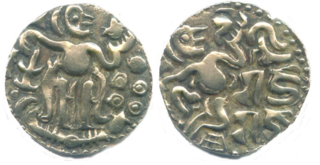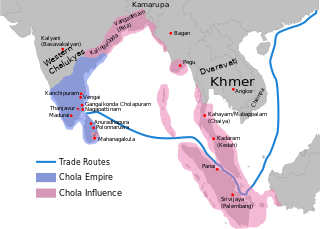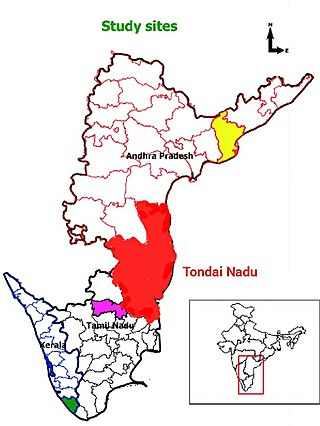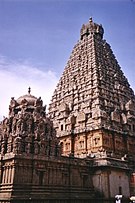
Kulottunga I also spelt Kulothunga, born Rajendra Chalukya, was a Chola Emperor who reigned from 1070 to 1122 succeeding his cousin Athirajendra Chola. He also served as the Eastern Chalukya monarch from 1061 to 1118, succeeding his father Rajaraja Narendra. He is related to the Chola dynasty through his mother's side and the Eastern Chalukyas through his father's side. His mother, Ammangaidevi, was a Chola princess and the daughter of emperor Rajendra I. His father was king Rajaraja Narendra of the Eastern Chalukya dynasty who was the nephew of Rajendra and maternal grandson of Rajaraja I. According to historian Sailendra Nath Sen, his accession marked the beginning of a new era and ushered in a period of internal peace and benevolent administration.

Pudukkottai is the administrative headquarters of Pudukkottai District in the Indian state of Tamil Nadu. Pudukottai Municipal Corporation is located on the banks of the Vellar River. It has been ruled, at different times, by the mutharaiyar dynasty, Cholas, Early Pandyas, Thondaimans, and the British. It is situated about 395 kilometres (245 mi) southwest of the state capital Chennai and about 55 kilometres (34 mi) southeast of Tiruchirappalli. Tamil Nadu's first woman Asian Games competitor, Santhi Soundarajan, is from Pudukkottai.

Rajadhiraja I was a Chola emperor, as the successor of his father, Rajendra I. He was the only Chola emperor who was killed while leading his army in war, and although he had a short reign, he helped his father conquer several territories as well as to maintain the Chola authority over most of Sri Lanka, Eastern Chalukya and Kalinga, among others. He also established imperial relations with overseas allies despite a series of revolts in the territory.

The Chola dynasty was a Tamil dynasty originating from southern India. At its height, it ruled over the Chola Empire, an expansive maritime empire. The earliest datable references to the Chola are from inscriptions dated to the 3rd century BCE during the reign of Ashoka of the Maurya empire. The Chola empire was at its peak and achieved imperialism under the Medieval Cholas in the mid-9th century CE. As one of the Three Crowned Kings of Tamilakam, along with the Chera and Pandya, the dynasty continued to govern over varying territories until the 13th century CE.

The Chola Empire, which is often referred to as the Imperial Cholas, was a medieval Indian, thalassocratic empire that was established by the Chola dynasty that rose to prominence during the middle of the ninth century and united southern India under their rule.

The region of Tamil Nadu in the southeast of modern India, shows evidence of having had continuous human habitation from 15,000 BCE to 10,000 BCE. Throughout its history, spanning the early Upper Paleolithic age to modern times, this region has coexisted with various external cultures.
Aranthangi is a town in Pudukkottai district in the state of Tamil Nadu, India. As of 2011, it had a population of 40,814.

Pudukkottai was a kingdom and later a princely state in British India, which existed from 1680 until 1948.
Sriman Hiranyagarbha Ravikula Raja Muthu Vijaya Raghunatha Raja Raghunatha Deva Kilavan Setupati was the first king of Ramnad Kingdom which is also known "Maravar Kingdom". He ruled from 1673 to 1708 and oversaw the growth of the feudal chieftainship of Ramnad into a powerful "Ramnad Kingdom" which is known as "Maravar Kingdom". He rescued the Nayak of Madurai from the tyranny of Rustam Khan and also successfully campaigned against the King of Thanjavur, who later ceded all his territories. It is recorded in the Sethupati copper plates that he belonged to the Surya kulam and Kashyap gothram.

The Thondaimans are chieftains who ruled the region in and around Pudukottai from the 17th to 20th century. The Pudukkottai Thondaiman dynasty was founded by Raghunatha Thondaiman, the brother-in-law of the then Raja of Ramnad, RaghunathaKilavan Setupati. The Pudukottai Samasthanam was under Thondaiman dynasty for one year even after Indian Independence. The Thondaiman dynasty had a special Valari regiment.
Raja Sri Brahdamba Dasa Raja Sri Rajagopala Tondaiman Bahadur was the ninth and last ruler of the princely state of Pudukkottai.
Raghunatha is a given name. Notable people with the name include:

Karunakara Tondaiman was a general of Chola Emperor Kulottunga I. He is renowned for leading the Chola invasion of Kalinga during the reign of Kulottunga I and is the hero of Jayamkondar's poem Kalinkkattuparani In the Parani poem he is referred to as the lord of Vandai. while in the Draksharamam inscription of Kulottunga I, he is called as Vanduvaraja and Pallavaraja. He also served as a minister under Kulothunga Chola's son and successor, Vikrama Chola.

The Kokarneswarar Temple is situated in town of Thirukokarnam located 5 kilometres from the town of Pudukkottai in the Tamil Nadu, India. The presiding deity is Kokarneswarar considered to be a form of the Hindu God Shiva. His consort Brihadambal is the family deity of the Thondaiman kings which ruled the princely Pudukkottai state. The Pallava-era rock-cut temple was constructed by the Pallava king Mahendravarman I sometime around the middle of the 7th century CE. Later additions were made in the early 2nd millennium by the Chola and Pandya dynasties.
Raja Sri Raghunatha Raya Tondaiman (1641–1730) was the ruler of the Pudukkottai kingdom from 1686 to 1730. A feudatory chieftain of the Sethupathi of Ramnad, in 1686, Raghunatha Raya Tondaiman was recognised as the independent ruler of Pudukkottai by the Sethupathi for the services he had rendered him.

Tondaimandalam, also known as Tondai Nadu, is a historical region located in the northernmost part of Tamil Nadu and southernmost part of Andhra Pradesh. The region comprises the districts which formed a part of the legendary kingdom of Athondai Chakravarti. The boundaries of Tondaimandalam are ambiguous – between the river basins of Penna River and Ponnaiyar River. During the reign of Rajaraja I, this region was called as Jayankonda Cholamandalam.

Tamil dynasties are the kingdoms who ruled over present day Tamil Nadu, Sri Lanka, Andhra Pradesh, Karnataka, Kerala and Odisha. These include the Pallavas, the Pandyas, the Cholas and the Cheras.
Manimangalam is a small town located in the Kanchipuram district of Tamil Nadu state in Southern India, famous for its ancient temples and inscriptions documenting the history of the ancient Tamil kings













